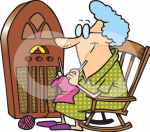This
is a Special Chapter, where the author discusses his radio hobby monitoring philosophy and achievements over many decades.
BACKGOUND
I have been involved in radio monitoring and QSLing as a hobby since 1954, and I would like
to share with you some thoughts about these pursuits.
Since I first started sending shortwave reports for QSLs back
in 1954, the total has now reached 10,958 - none on duplicate frequencies for any given "station".
On mediumwave, I have some 600 QSLs from 117 countries, but I retired from that field many years
ago due to the sheer impossibility of achieving anything worthwhile from Melbourne due to: all Australian channels now occupied
by 24-stations (no NSPs!) - nearly 20 stations operating from Melbourne - appalling technical operating standards (spurs -
shared towers) - bad local powerline interference.
I also have several hundred QSLs from Utility stations, from from
over 100 countries.
WHAT IS A QSL?
In the old days, a QSL was a card or letter issued by the station to verify information contained
in a reception report, which indicated that the submitted details were checked for accurancy with the station's records. QSLs
were expected to contain details as to date, time, and frequency, and a specific statement that the report had been checked
for accuracy.
I went along with those "rules", but I have always been intrigued at why people sent reception reports
to stations asking that the details be checked, and then issueing a QSL which sated that it was indeed their station which
was heard.
Why send a report if the identity of the station is unknown!
In the ensuing decades, the meaning
of the term "QSL" has broadened, and many stations issue simple "thank you for your report" cards or letters, either postal
or email, with no details at all. Such responses are not really considered by sopme hobbiests to be valid QSLs.
WHAT IS A "STATION"?
On SW, the term "station" means different things to different people.
My interpretation
is based on the document "QSL STANDARDS AND STATION COUNTING GUIDELINES" which some of
us developed in the 1980s for the now defunct Australian DXing Federation. Those Guidelines had existed in fragemented form
since the 1950s and we brought toghether all relevant features in a single manual, which was a multi-paged A4 printed book.
The
concepts in the manual are quite valid today, decades later!
These guidelines use the term "Station" to denote a "broadcasting
entity", if it satisfies all of these conditions:
- has its own mailing address for reports
- issues its own QSLs
- has a recognisable schedule
Prepared cards are not really within the spirit of these
guidelines, except on rare occasions!
National and International services from any given broadcaster constitute separate
stations, even if using the same frequency and transmitter, but at different times.
Different transmitter sites of a given broadcaster constitute separate stations.
The multitudes of programs
emerging from religious broadcasters do not normally constitute status as separate "stations" under these guidelines, unless
they conform with the general definition (above) of a station.
A frequency difference of at least 5 kHz applies to
"count" a new QSL for any given station.
I do not consider "stations heard" as a meaningful objective - my primary
interest is in reporting for QSLs.
CLASSIFICATION
OF RADIO COUNTRIES
Counting of countries is based on the DXCC philosophy, tried and tested over a great many
years, using the concept of the "deleted country" caused by amalgamation, secession, war, annexation or division. Arbitary
sub-categorisation of non-political "countries" occurs for "Indonesia", "China", "Papua New Guinea" (etc).
Clandestine,
pirate and other non-official stations pose particular problems, and personally I don't go near them! That is a matter of
personal choice, however.
Unlike some country lists, the Guidelines are holistic, and apply to LW, MW, SW, VHF, VHF,
TV, and exist irrespective of whether transmitters actually operate there.
ACHIEVEMENTS
As at
May, 2012, my 10,958 reception reports have yielded 8,471 QSLs, a response rate of nearly 80%, from 1,057stations, 220 current
countries, 24 deleted countries. I no longer send any form of costly inducements with reports - no IRCs, no money, no stamps,
no badges, no maps, no calendars, no cassettes, no cds/DVDs, no address labels. However, I do send a nice postcard of Australian
scenes with each report, and sometimes a recent photo of me. I do not bother with E-mail reports, except on very rare occasions.
Neither do I send recordings!
All reports are in English, using my own PC generated personalised colored Report Letter,
which also talks about me, my interests, home, and family.
My
record-keeping is simple:
1. Ordinary file cards in order of Country, showing station, frequency, date reported, date
QSLd
2. Ordinary A4 exercise books showing report designator (a number), date of report, time of report, frequency,
language, station, date QSL received
3. Ordinary A4 books showing QSL
designator (a number), station, frequency, progressive station count, progressive country count, progressive grand total of
QSLs count
4. Thumb-indexed book in alphabetical order of country showing
stations QSLd (name, frequency, and dates)
I do not bother with computerisation
of any of this stuff - neither do I retain the original reports, either print or audio. If something fails to respond, I will
prepare a fresh report - if the station has closed down, then too bad! I do not send follow-up reports.
The QSLs are
filed in cabinets, one folder for each radio country. Computerisation of all these records would take forever, and the benefits
(to me) are not worth the bother and time. The present manual system suits me fine.
All my QSL reports are hand-written.

